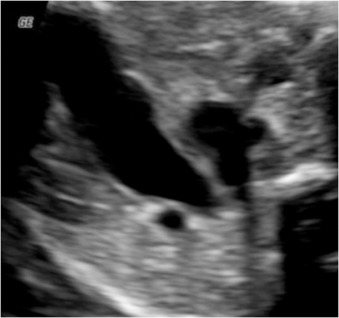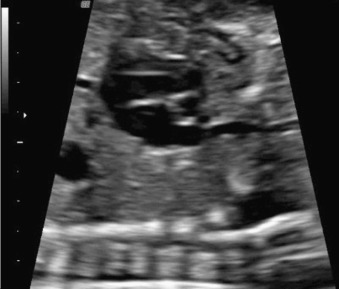Abstract
Anomalies of systemic venous return include left superior vena cava, absence of inferior vena cava, and agenesis of ductus venous among others. They might be isolated but commonly associated to chromosomal anomalies or complex heart diseases. Isolated cases have a good prognosis.
Keywords
left superior vena cava, absence of inferior vena cava, agenesis of ductus venous, right absent superior cava, persistent right umbilical vein, total anomalous systemic venous return
Introduction
Congenital anomalies of systemic venous drainage represent a heterogeneous group of malformations. The most frequently reported anomalies are persistent left superior vena cava (PLSVC), absence of inferior vena cava (IVC), and agenesis of the ductus venosus. More rarely, right absent superior vena cava, persistent right umbilical vein, and total anomalous systemic venous return toward the coronary sinus have also been reported prenatally.
Abnormal systemic venous drainage may be isolated or associated with complex heart diseases, mainly heterotaxy syndromes ( Chapter 91 ), and chromosomal defects. Prognosis depends mainly on the association with other anomalies.
Disease
Definition
Anomalies of systemic venous return include abnormalities of the umbilical, portal, hepatic, and caval venous systems.
Prevalence and Epidemiology
Anomalous systemic venous return is rarely seen prenatally. The estimated prevalence is 0.3% to 0.5%.
Etiology and Pathophysiology
Although knowledge of the normal anatomy of the fetal venous system has increased enormously, little information is available on the mechanisms leading to abnormal in utero development. Anomalies of systemic venous drainage represent a heterogeneous group of malformations including abnormalities in cardinal, umbilical, and vitelline veins. The most common anomalies are described next.
Persistent Left Superior Vena Cava
PLSVC is the most common congenital anomaly of the thoracic venous system; it occurs in 0.3% to 0.5% of the general adult population and accounts for 10% of cases of congenital heart disease (CHD). PLSVC results when the left superior cardinal vein caudal to the innominate vein fails to regress. In most cases, there is a normal right superior vena cava. However, in rare cases, the right superior vena cava is absent, and the left superior vena cava becomes the only systemic vein draining blood from the upper part of the body back to the heart. PLSVC drains into the coronary sinus, the right atrium, or both atria, via an unroofed coronary sinus leading to a dilated coronary sinus ( Fig. 92.1 ).

PLSVC is located to the left of the ductal arch and creates a “four-vessel” instead of three-vessel view in the high axial sections ( Fig. 92.2 ). A parasagittal section shows a typical “pipe” sign ( Fig. 92.3 ). PLSVC is most commonly observed as an isolated finding, but it can also be associated with other cardiovascular abnormalities, including atrial septal defect, bicuspid aortic valve, coarctation of the aorta, coronary sinus ostial atresia, and cor triatriatum. In the absence of other congenital abnormalities, PLSVC draining into the coronary sinus is an asymptomatic condition with no hemodynamic significance.


Inferior Vena Cava Interruption
IVC interruption with azygos or hemiazygos vein continuation is considered to be a rare congenital anomaly. The estimated prevalence is 0.6% to 2% in the presence of congenital heart disease (CHD) and less than 0.3% in otherwise normal fetuses. This malformation results from a connection failure between the right subcardinal vein and the right vitelline vein. Consequently, the venous blood from the caudal part of the body reaches the heart via the azygos or hemiazygos vein through the superior vena cava. Systemic venous flow beyond this point is compensated by the dilated azygos and hemiazygos arch (see Fig 90.1 , Fig 90.2 , Fig 90.3 ). Interrupted IVC is usually associated with visceral heterotaxy and cardiac anomalies. Most of the published literature addresses interrupted IVC as a marker of left atrial isomerism, and both entities are associated in most publications. However, there are some reports of isolated cases with good prognosis.
Agenesis of the Ductus Venosus
Agenesis of the ductus venosus is a rare condition resulting from failure of the embryonic anastomosis between the primitive portal and systemic venous systems. Outcome is related to the associated anomalies and may be affected by agenesis or underdevelopment of the fetal portal system. The presence of associated congenital anomalies and premature delivery are associated with poor prognosis in fetuses with ADV. In most cases, the umbilical vein has intrahepatic drainage with a good prognosis. Less frequently, the umbilical vein drainage is extrahepatic (portosystemic shunt), leading to a higher risk of heart failure and hydrops. These cases usually manifest with cardiomegaly in the third trimester ( Fig. 92.4 , ![]() ) and should be monitored once or twice a month to detect early signs of heart failure. The postnatal outcome depends mainly on the association with other anomalies. If the anomaly is isolated, the prognosis is generally excellent.
) and should be monitored once or twice a month to detect early signs of heart failure. The postnatal outcome depends mainly on the association with other anomalies. If the anomaly is isolated, the prognosis is generally excellent.











